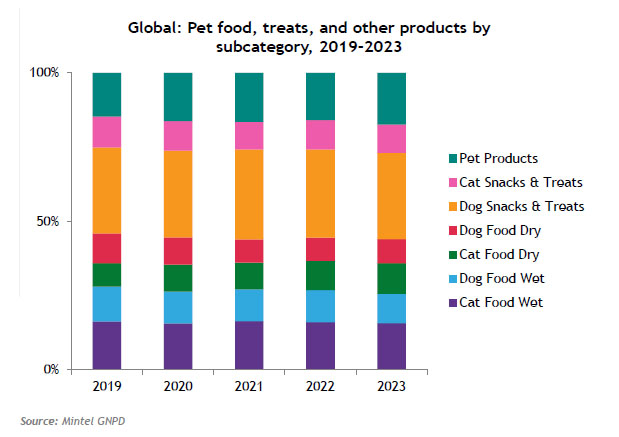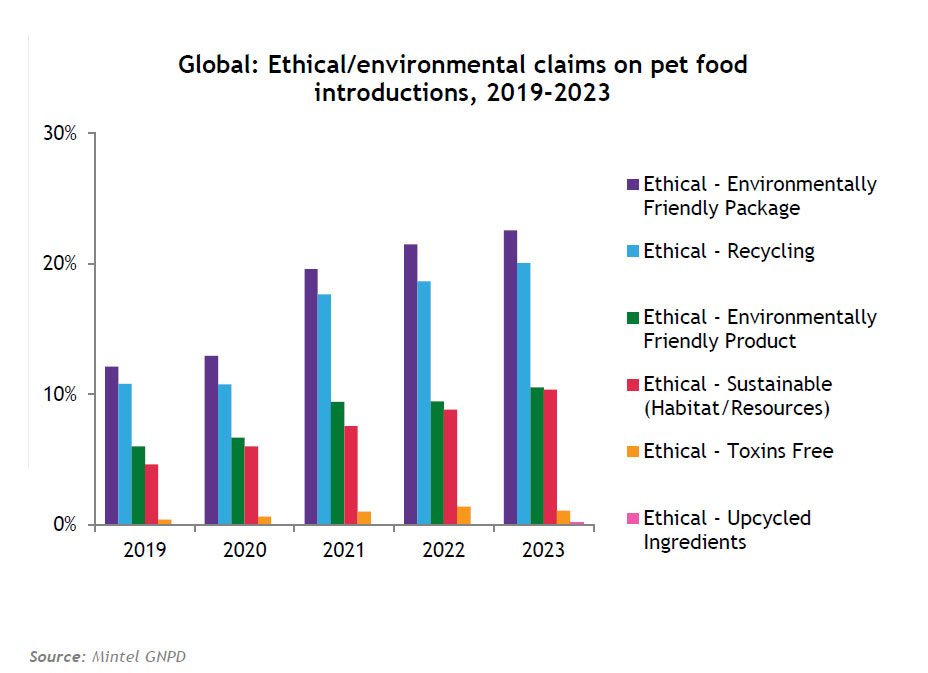ATLANTA — Personalization, naturalization and sustainability — these are the key, emerging trends to keep an eye on, according to Lynn Dornblaser, director of innovation and insight at Mintel. During the International Production & Processing Expo (IPPE), Dornblaser spoke about these trends seen throughout the pet food industry at the American Feed Industry Association’s (AFIA) 2024 Pet Food Conference on Jan. 30.
Dornblaser began his presentation by briefly sharing insights on new nutritional products entering the market, revealing the dog and cat food market shows more innovation and brand strength compared to the food industry. and human drink. Breaking down into product formats, dog snacks and treats cover most of the pet food category, followed by wet cat food, then dry cat food, wet dog food, cat snacks and treats, and, finally, dry dog food.
Of these new product launches from 2019 to 2023, approximately one-third came from new companies or new brands within the pet space, a trend higher than in human food. Breaking them down by type of launch, completely new products are followed by new types or line extensions, then by new packaging, relaunches and, finally, new formulations. For reference, in the human food space, Dornbalser shared new packaging sizes or graphic changes are more common launches than a completely new product.
 Source: Mintel GNPD
Source: Mintel GNPD
Wet formulas for dogs and cats have the largest number of product introductions worldwide. According to Dornblaser, wet foods for dogs and cats tend to see more product launches than for dry, with the largest percentage of pet food launches occurring in Europe. From 2019 to 2023, new wet cat food products dominated the markets in Europe, Asia Pacific and Middle East, and Africa, while new wet dog food products dominated the North American market.
In general, dog and cat foods tend to be branded, not private label, according to Dornblaser. However, Europe has the largest percentage (about 25%) of private label dog and cat food, with North America close at 20% private label. Asia Pacific has the smallest percentage of private label dog and cat foods, with Latin America also boasting a small percentage.
Taking it personally
As the term “health” has evolved for pet parents, nutritional solutions for pets have evolved as well. According to Dornblaser, pet parents are looking for formulas that provide specific health benefits to their four-legged companions, and among them is weight management.
According to the Association for Pet Obesity Prevention (APOP), more than half of all dogs and cats were classified as overweight or obese in 2018, considering pet obesity an epidemic. Many pet parents are aware of this issue and have become determined to help their pets lose weight, driving the demand for more versatile pet foods.
Additionally, according to Dornblaser, pet parents are taking a more personalized approach to addressing the “pet obesity crisis” around the world. For example, in France, about 33% of pet food buyers believe their pet would benefit from losing some weight. This belief is also more popular among younger pet owners, as 41% of consumers aged 16 to 34 think their pet would benefit from losing weight. Taking it a step further, in the United Kingdom, 62% of pet food buyers who agreed their pet would benefit from weight loss expressed interest in personalized meal plans.
As well as focusing on weight management, other popular health claims include high or added protein, high or added fiber, low or reduced fat, low or reduced calories, and high satiety.
Personalized pet foods have gained popularity across the global market. According to Dornblaser, 45% of Chinese pet owners are likely to buy formulas designed specifically for their pets, and 31% of German pet food buyers are interested in personalized that diet plan. Personalized formulas may also put off US consumers, as 54% of these pet food shoppers claim there are too many options in the pet food aisle, making it difficult for them to choose the right product for their pet.
As consumers become more aware of pet health and wellness, many are switching up their pets’ diets. According to Dornblaser, in the United States the main reason for changing pet food in 2022 is to improve health and well-being, with improving palatability second and saving money in the bottom third.
Looking to the future in personalization, DNA testing could prove opportunities for increased innovation. Pet DNA testing continues to gain popularity among consumers looking for additional insights into their pet’s health, and many may begin looking for formulas that take genetics into account. According to Dornblaser, 31% of French pet owners are willing to pay to have their pet’s DNA tested to find out the healthiest diet for their pet, rising to 45% for owners of a pet between the ages of 16 to 34. However, the high price of genetic testing can be a barrier.
Keeping it natural
In addition to personalization, naturalization is an emerging trend in pet food. This trend tends to sharpen its focus on removing artificial ingredients, and spurred growth in chilled/frozen formats, according to Dornblaser.
According to Mintel, 38% of US pet parents are looking for natural pet foods. But this trend is not only seen in the United States, its prevalence is everywhere in the world. For example, 49% of pet owners in China said they would buy a pet food product if it were natural.
Naturalization can take many forms, from the number of ingredients to the specific exclusion of “bad” ingredients. In the United States specifically, 23% of pet parents look for pet nutrition products that offer limited ingredient lists. However, there remains a global focus on avoiding “bad” ingredients, such as additives or artificial ingredients.
The most popular naturalization claims are “no additives or preservatives” and “free from” claims including free from added/artificial colors or flavors. Additional claims include “GMO-free,” “all-natural,” and “organic.”
In order to provide more natural food to their pets, many consumers are turning to fresh formulas, as these refrigerated/frozen products are more likely to feature some kind of natural claim compared to their shelf-stable counterparts, according to Dornblaser. Despite the growing popularity of these fresh pet foods, only 1% of product launches worldwide are chilled or frozen.
Promoting sustainability
Sustainability is far from an emerging trend in the pet food industry, and a variety of new sustainability claims are emerging, especially those related to packaging, according to Dornblaser. Pet food products that make environmental and ethical claims continue to grow with a major focus on packaging, ingredients and resource use.
 Source: Mintel GNPD
Source: Mintel GNPD
Environmental protection can be seen all over the world. In the United States, 61% of pet food buyers want brands to limit their impact on the environment. In Colombia and Mexico, 62% of consumers say they consider packaging environmentally friendly when choosing any human or pet food and drink. In Italy, 79% of pet parents want to learn more about the footprint of the pet foods they buy. And in Germany, 54% of pet owners prefer ethical alternatives to regular pet products.
Most sustainability initiatives in the pet food industry revolve around packaging, whether reducing the use of plastic or moving towards recyclable, reusable or compostable alternatives. However, packaging is not the only thing that consumers focus on.
In an effort to understand the environmental impact of their pets, consumers are looking to sustainable ingredients, from protein alternatives and interest in GMO-free formulas to less use of pesticides/hormones and more ethical procurement and farming practices.
Regenerative agriculture is a popular trend in human nutrition that is slowly making inroads into pet nutrition. Accordingly, 74% of US consumers believe companies should be more transparent about their farming practices, according to Dornblaser.
Upcycled ingredients are also a growing trend in both human and pet food. Sixty-eight percent of consumers in France think that food made from “leftover ingredients” has a positive impact on the environment, and in Poland 58% of pet food buyers are interested in pet food made from ingredients that would otherwise be wasted.
As the pet food industry moves beyond sustainable packaging and alternative ingredients, Dornblaser expects the next focus to be on resource use, with an eye on reducing water use.
Overall, these trends will undoubtedly continue to shape the pet food industry, showing promise for advanced innovations that not only meet consumers’ changing needs, but also support the health of pet.
Read more coverage from the 2024 Pet Food Conference.
Stay up to date with the latest pet food trends on our Trends page.


